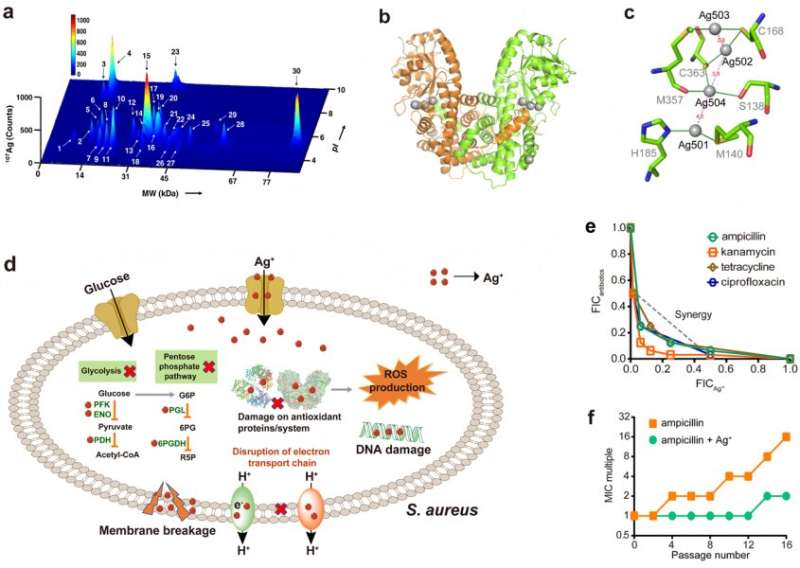Combating antibiotic-resistant Staphylococcus aureus

A research team led by Professor Hongzhe Sun, Norman & Cecilia Yip Professor in Bioinorganic Chemistry and Chair Professor from Research Divison for Chemistry and Department of Chemistry, Faculty of Science, in collaboration with Dr. Richard Yi-Ysun Kao, Associate Professor from the Department of Microbiology, Li Ka Shing Faculty of Medicine, and Dr. Aixin Yan, Associate Professor from School of Biological Sciences, the University of Hong Kong (HKU), discovers that silver (Ag)-based antimicrobials can effectively combat antibiotic resistant Staphylococcus aureus by targeting multiple biological pathways via functional disruption of key proteins and can be further exploited to enhance the efficacy of conventional antibiotics as well as to resensitise methicillin-resistant Staphylococcus aureus (MRSA) to antibiotics.
The study resolves the long-standing question of the molecular targets of silver in Staphylococcus aureus and offers insights into the sustainable bacterial susceptibility of silver, providing a new approach for combating antimicrobial resistance. The ground-breaking findings are now published in a leading multidisciplinary science journal Nature Communications.
Background
Antibiotics are medicines designed to kill bacteria and treat bacterial infections. Antibiotic resistance occurs when bacteria adjust in response to the misuse or overuse of these medicines, and it has become one of the biggest public health challenges in this era. At least 2.8 million people get an antibiotic-resistant infection annually in the US, and more than 35,000 people die from it.
Staphylococcus aureus , a round-shaped Gram-positive bacterium, is a dangerous and versatile pathogen for humans and is estimated that approximately 30% of the human population are asymptomatic nasal and long-term carriers. Staphylococcusis the causative agent of a variety of diseases, such as skin infection, food poisoning, bone/joint infection, and bacteremia, ranging from subacute superficial skin infection to life-threatening septicemia. The rise in incidence has been accompanied by an increase in antibiotic-resistant strains, especially MRSA. Moreover, the outbreak of the Coronavirus Disease 2019 (COVID-19) pandemic may further increase antimicrobial resistance due to the heavy use of antibiotics to treat patients infected with Severe Acute Respiratory Syndrome Coronavirus 2 (SARS-COV-2). Given the rapid emergence of drug-resistant Staphylococcus aureus but a lack of antibiotic-development pipeline, alternative strategies are urgently needed to combat antibiotic-resistant Staphylococcus aureus.
Key findings
Metal ions have been historically used as antimicrobial agents owing to their inherent broad-spectrum antimicrobial properties and less chance of resistance. There is a growing interest in revitalizing metal-based compounds as promising alternatives to tackle the antimicrobial resistance crisis. Silver ions (Ag+) and silver nanoparticles (AgNPs) have been used as antimicrobial agents for centuries and are still being widely used in the healthcare and food industry. Previously, the team has built a technical platform named LC-GE-ICP-MS to systematically identify Ag+-proteome in Escherichia colia nd developed a strategy named metabolome reprogramming to enhance the efficacy of antibacterial metallodrugs.
In this study, using the customized approach of LC-GE-ICP-MS, the team successfully separated and identified 38 authentic Ag+-binding proteins (Ag+-proteome) in Staphylococcus aureus at the whole-cell scale. In combination with bioinformatics analysis and systematic biochemical characterisation, they demonstrate that Ag+exploits a shotgun action through targeting multiple proteins, thus interfering with multiple pathways, including glycolysis, oxidative pentose phosphate pathway (oxPPP), and reactive oxygen species (ROS) stress defense system, to exert its bactericidal effect against Staphylococcus aureus. Further studies unveiled that oxPPP served as a vital pathway targeted by Ag+ in Staphylococcus aureus, with 6PGDH identified as the key enzyme involved in the inhibitory effects of Ag+ against Staphylococcus aureus. They resolved the first crystal structures of 6PGDH from Staphylococcus aureus both in substrate-bound and Ag-bound forms and revealed that Ag+abolished the enzymatic activity of 6PGDH through targeting Histidine 185 in the active site and morphing its catalytic pocket. This study resolves the long-standing question on the molecular targets and mode of action of silver against Staphylococcus aureus. Such a unique mode of action of silver via targeting multiple pathways confers the inability to select silver-resistant Staphylococcus aureus and endows it with the sustainable efficacy against Staphylococcus aureus.
Based on the uncovered molecular mechanism, they further demonstrate that Ag+/AgNP can potentiate the efficacy of a broad range of antibiotics, resensitise MRSA to antibiotics, and slow down the evolution of antibiotic resistance in Staphylococcus aureus. Therefore, a combination of antibiotics with silver or other metal-based compounds or nanomaterials could serve as a promising strategy to suppress the selection effects of antibiotics, thus preventing the occurrence of primary antibiotic resistance and extending the lifespan of conventional antibiotics to relieve the current crisis of antibiotic resistance.
More information: Haibo Wang et al, Multi-target mode of action of silver against Staphylococcus aureus endows it with capability to combat antibiotic resistance, Nature Communications (2021). DOI: 10.1038/s41467-021-23659-y
Journal information: Nature Communications
Provided by The University of Hong Kong


















